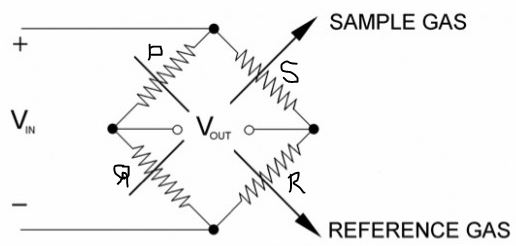A thermal conductivity gas analyzer is used to measure the chemical purity of a gas. The working of this type of analyzer is based on the difference in heat conductivity among gases.

Fig. 1 shows the Basic thermal conductivity gas analyzer circuit. It is a Wheatstone bridge formed with two sensing resistors acting as balanced legs of the bridge. One sensing resistor is surrounded by the sample gas to be analyzed and another resistor is surrounded by the reference gas such as oxygen, etc. Both gases are maintained at the same conditions i.e. same pressure, temperature, etc.
Initially, the Wheatstone bridge is balanced by exposing both sample and reference resistor to same gas. The bridge is balanced by adjusting resistor Q i.e. Vout = 0. In next step, the resistors are exposed to the gas sample and reference gas sample. If the gas sample contains elements having a different thermal conductivity than the reference gas sample, the Wheatstone bridge will be unbalanced. So, Vout is given in terms of the thermal conductivity.

Fast gas analyzers provided by vasthi brings you hints for engine modifications to reduce exhaust emmisions and fuel economy